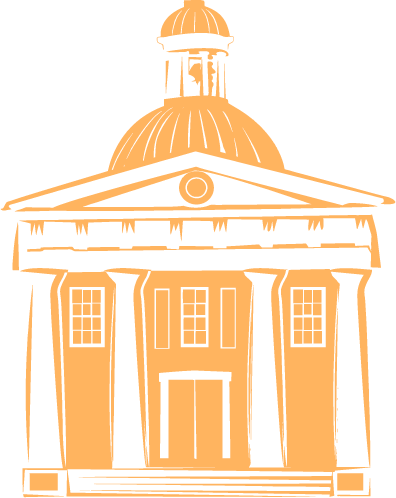The Neighborhood at a Glance
When John Lynch chartered the town of Lynchburg in 1786, the 45 acre town included today's Commerce, Main, and Church Streets, bounded on the east by Twelfth Street and Fifth Street to the west. With the entire town on a hill sloping down to the James River, the area was sometimes called “Lynchburg Hill.”
After Lynchburg’s court house was completed in 1813, it was discovered that the building was not in the town's limits. In 1814 the town boundaries were extended, and the name “Court House Hill” came into use.
Early Development
Court House Hill saw a number of early homes built with the John Warwick Daniel House completed in 1826 and the Carter Glass home on Clay Street in 1827. An important asset was added in 1829: the town funded a water system that took water from the James River and pumped it to a reservoir at Seventh and Clay Streets.
By 1830 the town had 4,600 residents and one of the earliest water systems in the nation. In 1855, the second Lynchburg Court House was built on the site of the original with a view down Water (or Ninth) Street to the river where Lynch's Ferry stood. In the late 1970’s, the second court house became the home of the Lynchburg Museum.
Church Street between Eighth and Tenth Streets ca. 1885
This photo shows progress on the construction of the new United States Court House and Post Office (now the “Monument Terrace Building”). Just to the left of the construction site, you can see the steps of Monument Terrace and the Fireman’s Memorial Fountain at the bottom.
Churches on Church Street
A number of churches were originally built on what became Church Street, but by the mid-20th century, they had all moved to other areas of the city. After 1880, large Catholic, Baptist, Methodist, Presbyterian, and Episcopal churches were built on Court and Clay Streets in the Romanesque and Gothic Revival Styles.
Allied Arts
Rising 17 stories, the Allied Arts Building was Lynchburg’s tallest skyscraper until 1972. It features distinctive yellow brick and locally sourced greenstone. It is one of the Hill City’s best examples of Art Deco architecture.
20th Century
As the 20th century began, Lynchburg had 19,000 residents and a new surge of development. The Academy of Music opened in 1905 on Main Street and brought nationally known talent to its stage. A new post office and several schools were built. The neo-classical Lynchburg National Bank opened at the corner of Ninth and Main Streets. As a memorial to World War I dead, Monument Terrace was completed in 1925. Court House Hill now had a grand stair to connect Church and Court Streets.
The Bluffwalk in Downtown Lynchburg
Lynchburg's Downtown was the center of government, commerce, and entertainment from the city’s founding through the 1960’s. As shopping centers were built and suburban living became popular, Downtown gradually faded, and most retail, restaurants, and entertainment moved to other areas of the city. Beginning with pioneering projects like Amazement Square, Riverviews Artspace, and the Craddock Terry Hotel in the early 2000’s—and gaining momentum each decade since—Downtown has come back to life as the heart of Lynchburg.






